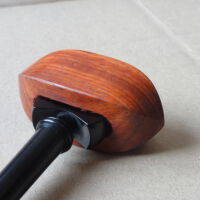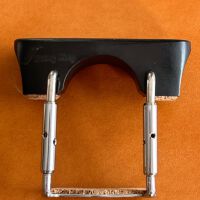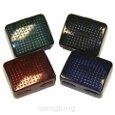Knilling Perfection Planetary Violin Pegs
Knilling Perfection Planetary Violin Pegs
A Classically-inspired Innovation
Perfection Planetary Pegs
Frequently Asked Questions:
What is the Perfection Peg?
The Perfection Peg is a deceptively simple mechanism with a size, shape and overall appearance
closely matching a conventional ebony peg. The patented design enables easy, accurate and stable
tuning of the violin, viola or cello without the use of tailpiece-mounted string adjusters. In concept,
this is equivalent to mechanisms already in use on the guitar and string bass.
What are the main benefits of Perfection Pegs?
- Ease, accuracy and stability of tuning. Perfection Pegs turn with great precision and
hold in the desired position until manually adjusted.
- Higher reliability and lower costs of maintenance. Perfection Pegs are virtually
maintenance free and don’t create wear-and-tear on the peg box.
How do Perfection Pegs work?
In basic terms, they employ gears—small, precise, incredibly strong helical gears. Rather than
whole-peg rotation and wood-on-wood friction, operation of the internally housed gearing brings
each string to its desired tension, and holds it securely in place.
Stated a bit more technically, a player, rotating the head of the peg, is actually turning the main gear
(called the sun gear). The sun gear drives smaller gears (called planet gears), which “orbit” between
the sun gear and a toothed outer housing (called a ring gear). As the orbiting planet gears are spun
about the sun gear, they force the rotation of an elongated housing (called a carrier), which serves as
the shaft portion of the peg. The gears are also designed so that the shaft rotates once for every four
turns of the peg’s head (called a four-to-one gear reduction). That allows the Perfection Peg to also
function as a fine tuner.
What about durability?
If anything, the Perfection Pegs may be over-engineered to ensure durability and longevity.
In fact, one might expect that Perfection Pegs will outlast any instrument in which they are installed!
Here are some of the details.
The working gears are made from 8650 thru-hardened steel alloy. This same alloy is commonly used
for the shafts that drive the propeller blades on helicopters. The ring gear assembly for the cello peg
is brass, while for the violin it is aircraft grade aluminum. The carrier/peg shaft assembly is also
aluminum. All of the internal parts are permanently lubricated with an ultra-viscous lubricant named
767A Nyogel, the same thing used in various sealed microscope, telescope and binocular gear
assemblies. The head is molded from a high-tech plastic called PBT/ABS and the opposite end of
the shaft is Delrin, both extremely durable materials.
For any reason, Perfection Pegs can be easily removed by a qualified luthier or technician, and
replaced with new Perfection Pegs or conventional ebony friction pegs.
What can happen to Perfection Pegs?
Perfection Pegs are designed for inherently superior reliability and problem-free operation, and
offer the many additional benefits that normal pegs lack. Because of their ease of use and ability to
hold the desired string tuning reliably, they are subject to significantly fewer instances of aggressive
handling than would be the case for poorly fit conventional pegs.
It is possible to temporarily seize up the gear mechanism of a Perfection Peg by shoving the head inward
with inappropriate force or from an impact on the peg’s head. If this should happen, the head should be
grasped and gently wiggled outward, working it in an alternating clockwise and counter-clockwise manner.
This should free the gears for normal operation. If a Perfection Peg becomes dislodged from the peg box,
it can be readily re-installed (by a qualified luthier or technician). Since the hole taper and diameter is the
same as a conventional peg, one can be used temporarily.
The head of the peg can also be snapped off with a heavy impact. The head can actually be replaced by
a qualified technician. (Note that in the event of such an impact, it is preferable for the peg head to snap
off than to transfer the impact shock to the scroll and neck, which could damage the instrument.)
Who can install Perfection Pegs?
Installation should be left to qualified technicians and luthiers. Perfection Pegs are not intended
for consumer/player installation.
Installation:
- PDF instruction
- YouTube instruction
A Classically-inspired Innovation
Perfection Planetary Pegs
Frequently Asked Questions:
What is the Perfection Peg?
The Perfection Peg is a deceptively simple mechanism with a size, shape and overall appearance
closely matching a conventional ebony peg. The patented design enables easy, accurate and stable
tuning of the violin, viola or cello without the use of tailpiece-mounted string adjusters. In concept,
this is equivalent to mechanisms already in use on the guitar and string bass.
What are the main benefits of Perfection Pegs?
- Ease, accuracy and stability of tuning. Perfection Pegs turn with great precision and
hold in the desired position until manually adjusted.
- Higher reliability and lower costs of maintenance. Perfection Pegs are virtually
maintenance free and don’t create wear-and-tear on the peg box.
How do Perfection Pegs work?
In basic terms, they employ gears—small, precise, incredibly strong helical gears. Rather than
whole-peg rotation and wood-on-wood friction, operation of the internally housed gearing brings
each string to its desired tension, and holds it securely in place.
Stated a bit more technically, a player, rotating the head of the peg, is actually turning the main gear
(called the sun gear). The sun gear drives smaller gears (called planet gears), which “orbit” between
the sun gear and a toothed outer housing (called a ring gear). As the orbiting planet gears are spun
about the sun gear, they force the rotation of an elongated housing (called a carrier), which serves as
the shaft portion of the peg. The gears are also designed so that the shaft rotates once for every four
turns of the peg’s head (called a four-to-one gear reduction). That allows the Perfection Peg to also
function as a fine tuner.
What about durability?
If anything, the Perfection Pegs may be over-engineered to ensure durability and longevity.
In fact, one might expect that Perfection Pegs will outlast any instrument in which they are installed!
Here are some of the details.
The working gears are made from 8650 thru-hardened steel alloy. This same alloy is commonly used
for the shafts that drive the propeller blades on helicopters. The ring gear assembly for the cello peg
is brass, while for the violin it is aircraft grade aluminum. The carrier/peg shaft assembly is also
aluminum. All of the internal parts are permanently lubricated with an ultra-viscous lubricant named
767A Nyogel, the same thing used in various sealed microscope, telescope and binocular gear
assemblies. The head is molded from a high-tech plastic called PBT/ABS and the opposite end of
the shaft is Delrin, both extremely durable materials.
For any reason, Perfection Pegs can be easily removed by a qualified luthier or technician, and
replaced with new Perfection Pegs or conventional ebony friction pegs.
What can happen to Perfection Pegs?
Perfection Pegs are designed for inherently superior reliability and problem-free operation, and
offer the many additional benefits that normal pegs lack. Because of their ease of use and ability to
hold the desired string tuning reliably, they are subject to significantly fewer instances of aggressive
handling than would be the case for poorly fit conventional pegs.
It is possible to temporarily seize up the gear mechanism of a Perfection Peg by shoving the head inward
with inappropriate force or from an impact on the peg’s head. If this should happen, the head should be
grasped and gently wiggled outward, working it in an alternating clockwise and counter-clockwise manner.
This should free the gears for normal operation. If a Perfection Peg becomes dislodged from the peg box,
it can be readily re-installed (by a qualified luthier or technician). Since the hole taper and diameter is the
same as a conventional peg, one can be used temporarily.
The head of the peg can also be snapped off with a heavy impact. The head can actually be replaced by
a qualified technician. (Note that in the event of such an impact, it is preferable for the peg head to snap
off than to transfer the impact shock to the scroll and neck, which could damage the instrument.)
Who can install Perfection Pegs?
Installation should be left to qualified technicians and luthiers. Perfection Pegs are not intended
for consumer/player installation.
Installation:
- PDF instruction
- YouTube instruction




